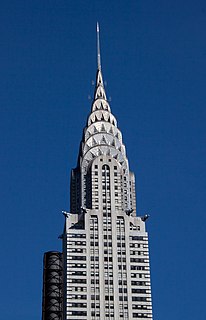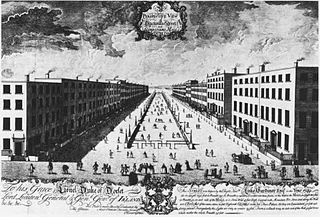
Art Deco, sometimes referred to as Deco, is a style of visual arts, architecture and design that first appeared in France just before World War I. It influenced the design of buildings, furniture, jewelry, fashion, cars, cinemas, trains, ocean liners, and everyday objects such as radios and vacuum cleaners. It took its name, short for Arts Décoratifs, from the Exposition internationale des arts décoratifs et industriels modernes held in Paris in 1925.

Bewley's is an Irish hot beverage company, located in Dublin and founded in 1840, which operates internationally. Its primary business operations are the production of tea and coffee, and the operations of cafés. Bewley's has operations in Ireland, the UK and the United States; in the Boston area under the Rebecca's Cafe name and in California as Java City.

The Wide Streets Commission was established by an Act of Parliament in 1758, at the request of Dublin Corporation, as a body to govern standards on the layout of streets, bridges, buildings and other architectural considerations in Dublin. The commission was abolished by the Dublin Improvement Act of 1849, with the final meeting of the Commission taking place on 2 January 1851.
Ervia, previously known as Bord Gáis or Bord Gáis Éireann, is a multi-utility company distributing pipeline natural gas, water services and dark fibre services in Ireland. The state-owned company has built an extensive network across Ireland.

The General Electric Building is a skyscraper at the southwestern corner of Lexington Avenue and 51st Street in Midtown Manhattan, New York City. The building, designed by Cross & Cross and completed in 1931, was known as the RCA Victor Building during its construction. The General Electric Building is sometimes known by its address to avoid confusion with 30 Rockefeller Plaza, which was once known as the GE Building.

William Harold Lee was an American 20th century movie theater designer and later the chief architect for Eastern College. He was a protégé of acclaimed Philadelphia architect Frank Furness.

One Woodward Avenue, formerly known as the Michigan Consolidated Gas Company Building, is a class-A office skyscraper in Downtown Detroit, Michigan. Located next to the city's Civic Center and Financial District, it overlooks the International Riverfront and was designed to blend with the City-County Building across Woodward Avenue, Huntington Place, and the former Ford Auditorium to the south.

The David Stott Building is a 38 story high-rise apartment building with office space on floors 2-6 and retail space on the first floor. The "Stott" was originally built as a class-A office building located at 1150 Griswold Street in Downtown Detroit, Michigan, within the Capitol Park Historic District. It was designed in the Art Deco style by the architectural firm of Donaldson and Meier and completed in 1929. Bedrock Detroit owns and manages the building which began leasing in late 2018 and includes 107 apartment homes and 5 floors of commercial office space.

The AT&T Michigan Headquarters is a complex of skyscrapers and buildings located at 1st Street, Cass Avenue, State Street, and Michigan Avenue in Downtown Detroit, Michigan. It contains the AT&T Building, the AT&T Building addition, the Maintenance Shop and is owned by communications giant AT&T.
Scott Tallon Walker is an architecture practice with its head office in Dublin, Ireland and further offices in London, Galway and Cork. It is one of the largest architecture practices in Ireland. Established in 1931 as Scott and Good, becoming Michael Scott Architect in 1938, and Michael Scott and Partners in 1957 before changing to the current Scott Tallon Walker in 1975. Scott Tallon Walker and its earlier incarnations developed a reputation for modernism.

60 Hudson Street, formerly known as the Western Union Building, is a 24-story telecommunications building in the Tribeca neighborhood of Manhattan in New York City. Built in 1928–1930, it was one of several Art Deco-style buildings designed by Ralph Thomas Walker of Voorhees, Gmelin and Walker for telecommunications in the early 20th century. 60 Hudson Street spans the entire block between Hudson Street, Thomas Street, Worth Street, and West Broadway.

The Oklahoma Natural Gas Company Building is a historic building in Tulsa, Oklahoma, at 624 South Boston Ave. It was one of the first local Art Deco buildings built in the new Art Deco style, along with the Public Service of Oklahoma Building. This choice by the relatively conservative utility companies made the style acceptable in the city, with many Art Deco buildings built subsequently in Tulsa. The building was designed by Frank V. Kirshner and Arthur M. Atkinson. It was built of reinforced concrete, and clad in buff brick, except for the lower two stories, which are clad in limestone. The verticalness of the building is emphasized by piers rising the entire height of the facade with windows placed between the piers.

Westmoreland Street is a street on the Southside of Dublin. It is currently a one-way street. It carries a segment of the R138 road for northbound traffic; nearby D'Olier Street carries southbound traffic of that segment.

D'Olier Street is a street in the southern city-centre of Dublin, the capital of Ireland. It and Westmoreland Street are two broad streets whose northern ends meet at the southern end of O'Connell Bridge over the River Liffey. Its southern end meets Fleet Street, Townsend Street, College Street and Pearse Street.

Sir Patrick Dun's Hospital was a hospital and school for physicians on Grand Canal Street, Dublin, Ireland.

The Art Deco style, which originated in France just before World War I, had an important impact on architecture and design in the United States in the 1920s and 1930s. The most famous examples are the skyscrapers of New York City including the Empire State Building, Chrysler Building, and Rockefeller Center. It combined modern aesthetics, fine craftsmanship and expensive materials, and became the symbol of luxury and modernity. While rarely used in residences, it was frequently used for office buildings, government buildings, train stations, movie theaters, diners and department stores. It also was frequently used in furniture, and in the design of automobiles, ocean liners, and everyday objects such as toasters and radio sets. In the late 1930s, during the Great Depression, it featured prominently in the architecture of the immense public works projects sponsored by the Works Progress Administration and the Public Works Administration, such as the Golden Gate Bridge and Hoover Dam. The style competed throughout the period with the modernist architecture, and came to an abrupt end in 1939 with the beginning of World War II. The style was rediscovered in the 1960s, and many of the original buildings have been restored and are now historical landmarks.

Art Deco architecture flourished in New York City during the 1920s and 1930s, before largely disappearing after World War II. The style is found in government edifices, commercial projects, and residential buildings in all five boroughs. The architecture of the period was influenced not just by decorative arts’ influences from across the world, but also the 1916 Zoning Resolution which influenced the setback feature in most of the buildings.
Desmond FitzGerald was an Irish architect. His most notable work is the original Dublin Airport terminal building.

Hawkins Street is a street in central Dublin, Ireland. It runs south from Rosie Hackett Bridge, at its junction with Burgh Quay, for 160 metres (170 yd) to a crossroads with Townsend Street, where it continues as College Street.

Kodak House in an Art Deco building in the inner suburb of Rathmines in Dublin, Ireland. It was designed by architects Donnelly, Moore and Keatinge in 1930 and was built in 1932. It was originally the warehouse for Kodak Ireland and now houses an advertising agency and other businesses.



















